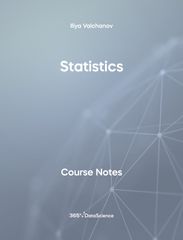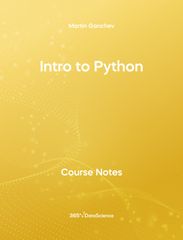Data Science Course Notes
Enhance your learning journey with in-depth data science lecture notes. Deepen your understanding of core concepts in data science, statistics, probability, Python, and machine learning.Course notes are the perfect complementary online data science study materials. They help you grasp fundamental concepts, refresh your memory when preparing for exams, and get a taste of our learning style.
Committed to your career success and development, we at 365 Data Science support you throughout your learning journey with free resources designed to enhance and guide your education. Our rich selection covers everything from data science notes for beginners to simplified explanations of advanced topics. Choose a subject you wish to master, download our free PDF course notes, and start learning.

SQL DELETE Statement Notes
Our SQL DELETE Statement notes provide a comprehensive guide to the SQL DELETE Statement—essential for removing unwanted data from your databases. What is the SQL DELETE Statement? The SQL DELETE statement is a fundamental SQL command that deletes existing records in a database. These notes explain the syntax needed to write effective DELETE SQL queries. You’ll learn about the DELETE FROM WHERE conditions command, which allows you to specify the exact SQL rows to delete. Understanding how to delete a row in SQL is crucial for maintaining clean and efficient databases. One of the critical aspects covered in these notes is the ON DELETE CASCADE option, which is part of the foreign key constraint. This option ensures that if a specific value from the parent table’s primary key is deleted, all corresponding records in the child table will also be removed. This feature is essential for maintaining referential integrity within your database. The notes also compare the SQL DELETE command with other SQL commands for removing data, such as TRUNCATE and DROP. The section on TRUNCATE vs DELETE highlights the differences in performance and usage scenarios between these two commands. The DROP vs TRUNCATE vs DELETE section also provides insights into when to use each command for optimal database management.
Learn More
SQL UPDATE Statement Notes
Our SQL UPDATE Statement notes offer a comprehensive guide to the SQL UPDATE Statement—essential for modifying existing data in your databases. What is the SQL UPDATE Statement? The SQL UPDATE is a crucial SQL command used to modify existing records in a database. These notes provide detailed information on the syntax needed to write effective SQL UPDATE statements. You learn about the UPDATE table_name SET column_1 = value_1 command, which allows you to update specific columns, and the SQL WHERE condition, which ensures you only update the desired records. Additionally, this guide covers SQL best practices for handling database updates to provide accurate and efficient data management. You can execute precise and controlled updates by mastering the SQL UPDATE syntax and understanding the use of TCL commands. The notes explore the TCL COMMIT and TCL ROLLBACK commands—essential for managing transactions in SQL. The COMMIT statement saves the transaction in the database, while the ROLLBACK clause allows you to revert to the last committed state, ensuring your data remains consistent and accurate.
Learn More
SQL Insert Statement Notes
Our SQL INSERT Statement Notes offer a comprehensive guide to the SQL INSERT Statement—essential for adding new data to your databases. What is the SQL INSERT Statement? The SQL INSERT statement is a vital SQL command to add new records to a database. This resource provides detailed information on the syntax needed to write effective INSERT statements. You can learn how to update your database and add new information, including the INSERT INTO statement—allowing you to add data to specific columns—and the INSERT INTO SELECT command, which facilitates inserting data from one table into another. Download these SQL INSERT Statement notes to thoroughly understand one of SQL's most essential commands. With this resource, you'll confidently manage and add data to databases—ensuring your data management practices are efficient and effective.
Learn More
SQL SELECT Statement Notes
Our SQL Select Statement notes offer an in-depth exploration of the SQL SELECT statement—essential for effectively querying and retrieving data from databases. What is the SQL Select Statement? The SQL SELECT statement is fundamental in SQL—allowing you to extract specific data from a database. This resource covers the core syntax required to write effective SELECT statements, including using SELECT FROM and the WHERE clause to filter data. You learn about the AND operator and OR operator for combining multiple conditions and understand operator precedence to ensure your queries return the correct results. Additionally, this resource explains how to use wildcard characters to search for patterns within your data and the BETWEEN AND clause for selecting values within a specific range. The IS NULL and IS NOT NULL conditions help you handle missing data, while various comparison operators allow precise data filtering.
Learn More
SQL Syntax & Theory Notes
SQL (Structured Query Language) encompasses a wide array of SQL commands that allow for comprehensive management and manipulation of databases. This resource explores the intricacies of SQL syntax and SQL commands, detailing: Data Definition Language (DDL) Data Manipulation Language (DML) Data Control Language (DCL) Transaction Control Language (TCL) It offers comprehensive insights into interacting with database objects. Key topics cover SQL syntax fundamentals—including basic structure and rules for crafting queries, essential SQL keywords for mastering SQL operations—and various statement types like CREATE, ALTER, DROP, RENAME, and TRUNCATE. By mastering these SQL commands and SQL keywords, you'll be well-prepared to handle any database-related task efficiently.
Learn More
SQL Notes: Basics
Our SQL Basics Resource offers a comprehensive overview of essential SQL concepts and commands—crucial for anyone looking to master database management and manipulation. Download our free SQL PDF and get started with SQL notes to help you understand the core of this essential query language. What is SQL? SQL (Structured Query Language) is the standard language for managing and manipulating databases. These SQL notes explore the language’s core elements, such as SQL Query Structure and essential commands for effective database interaction. They introduce: Data Definition Language (DDL) Data Manipulation Language (DML) Data Control Language (DCL) Transaction Control Language (TCL). This guide covers SQL Syntax—essential structures and rules for crafting queries. Learn to: Retrieve data with the SQL SELECT statement. Modify data using the SQL UPDATE statement. Add new entries with the SQL INSERT statement. Remove data via the SQL DELETE statement. You’ll also find information on SQL keywords, helping you familiarize yourself with essential terms and their uses. Additional topics include GROUP BY and HAVING—exploring grouping data and filtering group results—and the WHERE clause, which explains how to specify conditions for data retrieval. Explore SQL operators and SQL wildcards to refine queries, including SQL BETWEEN and SQL comparison operators for range-based selection and comparisons. This resource also explains SQL DISTINCT for filtering unique values and the distinctions between SQL TRUNCATE and SQL DELETE, which detail methods for removing data and deleting tables. The SQL PDF covers SQL GRANT and REVOKE for user permissions and database security, along with SQL database administration techniques for effectively managing and maintaining your databases.
Learn More


